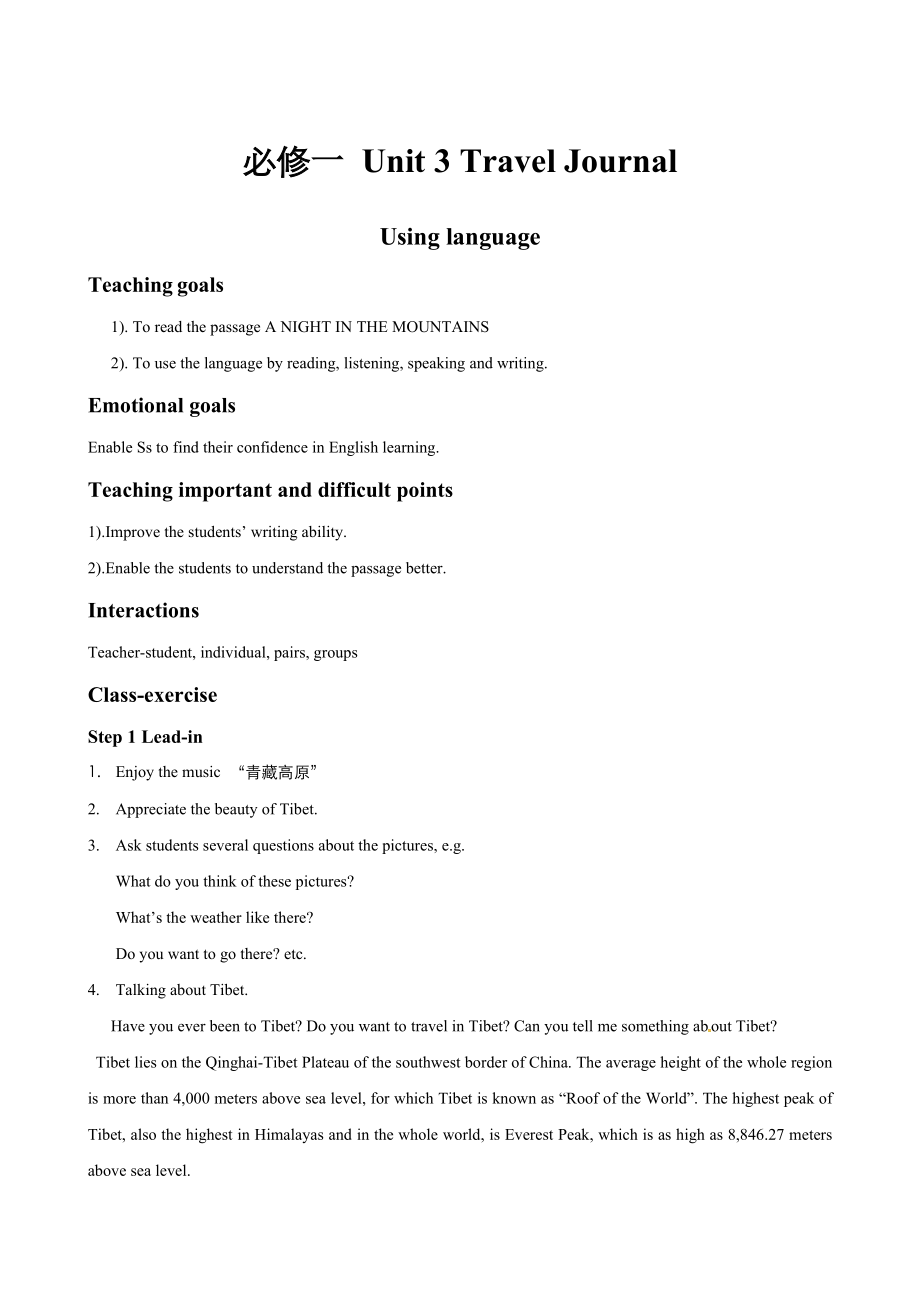《高中英語人教版必修1教案: Unit 3 Travel Journal Using language 教案2 Word版》由會(huì)員分享���,可在線閱讀���,更多相關(guān)《高中英語人教版必修1教案: Unit 3 Travel Journal Using language 教案2 Word版(3頁珍藏版)》請?jiān)谘b配圖網(wǎng)上搜索。
1����、 精品資料
必修一 Unit 3 Travel Journal
Using language
Teaching goals
1) . To read the passage A NIGHT IN THE MOUNTAINS
2) . To use the language by reading, listening, speaking and writing.
Emotional goals
Enable Ss to find their confidence in English learning.
Teaching
2、 important and difficult points
1).Improve the students’ writing ability.
2).Enable the students to understand the passage better.
Interactions
Teacher-student, individual, pairs, groups
Class-exercise
Step 1 Lead-in
1. Enjoy the music “青藏高原”
2. Appreciate the beauty of Tibet.
3. Ask stude
3�、nts several questions about the pictures, e.g.
What do you think of these pictures?
What’s the weather like there?
Do you want to go there? etc.
4. Talking about Tibet.
Have you ever been to Tibet? Do you want to travel in Tibet? Can you tell me something about Tibet?
Tibet lies on the Qing
4、hai-Tibet Plateau of the southwest border of China. The average height of the whole region is more than 4,000 meters above sea level, for which Tibet is known as “Roof of the World”. The highest peak of Tibet, also the highest in Himalayas and in the whole world, is Everest Peak, which is as high as
5�、 8,846.27 meters above sea level.
Although a part of China, Tibet has a unique culture of all its own. It is mainly inhabited by Tibetans, a minority nationality of old and mysterious people. Tourist attractions include the Potala Palace in Lhasa, Jokhang Temple, and a number of Buddhist sacred pl
6、aces.
Tibet (Xi Zang in Chinese) is to the south of Xin Jiang Uygur Autonomous Region and Qing Hai Province, to the west of Sichuan, to the northwest of Yunnan and to the north of India and Nepal. Its population of 2.3 million people come from a variety of ethnic groups including Tibetan, Han, Mon
7�����、ba and Lhota. Its capital city is Lhasa. Northwest Tibet, mainly Qing Hai plateau, is home to a variety of unusual and unique animals. Across the northern expanse of Tibet, you can see vast grasslands where horses, yak and sheep roam freely. The world's lowest valley, the Grand Yarlun-tzanpo River V
8��、alley lies in east Tibet. It is freezing cold in most time of the year. Most tourists come to visit Tibet only in the warmest seasons, June, July, August and early September.
Step 2 Reading
We know Wang Wei and Wang Kun have traveled down the Mekong. Today they have reached the Tibetan Mountain
9�����、s. They will stay there for a night. Now let’s look at the passage “A night in the mountains” on page 22. Read it quickly to find the main idea. Show some questions.
1. How does Wang Kun feel about the trip now?
2. What do you think has changed his attitude?
3. Is it natural for Wang Kun not to f
10、eel lonely?
4. Would you feel the same way in this situation? Why or Why not?
Step 3 Listen and mark
Let the students listen to the recorder and mark the rising and falling tone of each sense group and sentence. Then practice reading aloud. Pay attention to pronunciation and intonation.
Step 4 D
11���、ialogue
Suppose Wang Wei and Wang Kun leave their camp the next morning and go on with the journey. Make a short dialogue between them.
Sample dialogue :
--Oh , up so early?
--Early? It’s nearly 9 o’clock.
--Oops! (Look at his watch). I guess you’re right.
--Why were you so tired?
--Well, I
12�、stayed up late last night to watch the stars.
--That’s nice. They must be pretty.
--Yes, they are.
Then ask students to make up their own dialogues. They may discuss and practice in pairs.
Step 5 Guided writing
In this unit, we have read the first two parts of a travel journal and have listened
13����、 to the third part of the travel journal. What is the difference between a journal and a diary? Let’s read the passage on page 23 and find out the difference between the two.
Step 6 Homework
1. Finish writing the letter
2. Review the whole unit
3. Read the passage in workbook( page 59) “The end of our journey ”.
 高中英語人教版必修1教案: Unit 3 Travel Journal Using language 教案2 Word版
高中英語人教版必修1教案: Unit 3 Travel Journal Using language 教案2 Word版

